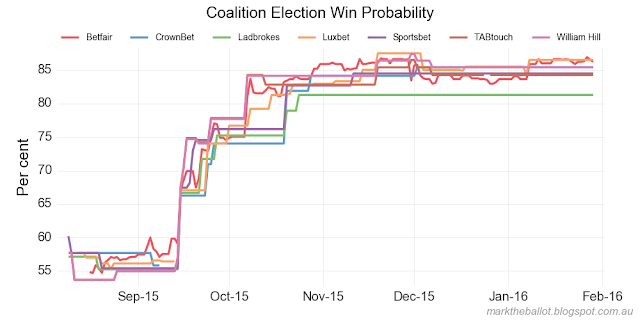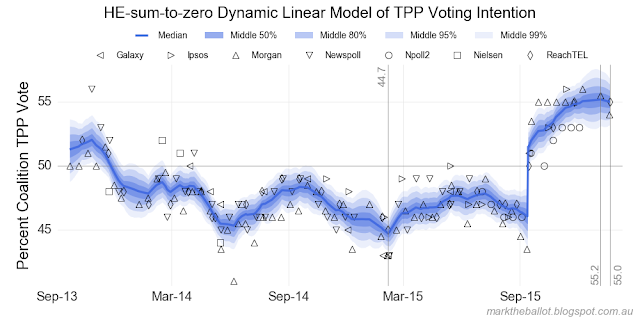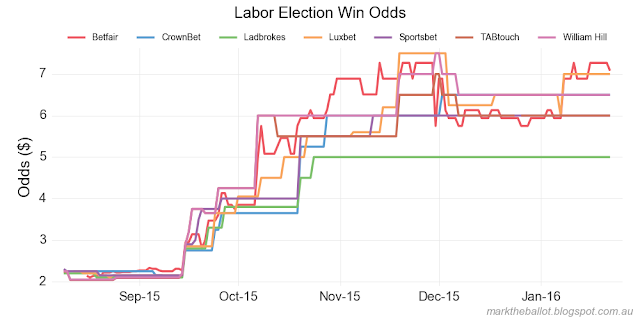The government's ascendancy in the opinion polls and the final report of the
Royal Commission into Trade Union Governance and Corruption has fuelled speculation on the possibility of an early double dissolution election. In this post I will look at some of the factors the government will need to consider in deciding whether to go for a double dissolution, and the timing of the subsequent election. We will begin our consideration with a discussion of normal election practice and timing.
What would be normal election practice and timing?
Australia has a maximum three-year term for the Federal House of Representatives. The three years is reckoned from the first sitting day of the House following the previous election. Following the 7 September 2013 election, the House first sat on 12 November 2013. While the government can call an election earlier, it cannot extend the life of the current House beyond 11 November 2016. An election must be held on a Saturday between 33 and 68 days after the house has been dissolved.
In practice, governments over the past 45 years have sought to synchronise elections for the House of Representatives with half-Senate elections. The Senate has six-year fixed terms for state Senators, with half of the state Senate seats up for election every three years. There are different rules for the election of territory-Senators, which do not affect the timing of elections. The last time Australia had a half-Senate election that was out-of-sync with an election for the House of Representatives was in 1970. Out-of-sync half senate elections allow (perhaps encourage) the public to express dissatisfaction with the government of the day, without changing the government. This can make the task of government for the incumbent very difficult.
Synchronising the House of Representative and half-Senate elections necessitates an election date on a Saturday somewhere between 6 August 2016 and 14 January 2017. As
school holidays and major sporting events are typically avoided, the latest an election is likely to be held is 10 December 2016. The school holidays would suggest the period 17 September to 15 October 2015 is unlikely. The 2016 Rio de Janeiro Olympics may preclude 6 August to 20 August 2016 (and perhaps the immediate Saturdays following). The AFL Grand Final is Friday 30 September and the NRL Grand Final is on Sunday 2 October, both of which provide an additional reason not to have an election on Saturday 1 October 2015.
In the normal scheme of things, the next Australian Federal election would in all likelihood happen on one of the following dates in in the second half of 2016: the first two Saturdays of September (3 and 10), the last two Saturdays of October (22 and 29), any Saturday in November (5, 12, 19 and 26), or the first two Saturdays of December (3 and 10). The earlier dates are more likely than the later dates.
What is a double dissolution?
Under the Australian Constitution, both houses of Parliament have almost equal legislative power (noting that the House of Representatives has supremacy when it comes to proposing legislation that spends money or raises taxes).
While a government must have the confidence of the House of Representatives, it may only have a minority of support in the Senate. The current government does not have a majority in the Senate.The absence of a government majority in the Senate can result in legislative disagreements between the House of Representatives and the Senate.
If there is an ongoing legislative disagreement between these two houses of Parliament,
section 57 of the Australian Constitution provides the government with a mechanism to break that disagreement. This section allows for a fresh election following the dissolution of both houses of Parliament in the circumstance where the Senate twice rejects or fails to pass legislation passed by the lower house at least three months apart.
This deadlock-resolution mechanism allows for the complete re-election of the entire Senate at a timing of the government's choice, as opposed to electing half of the Senate sometime within the 12 month period prior to the expiration of the half-Senate. If the government wins a double dissolution, and the Senate further rejects the legislative proposals, the government can call a joint sitting of both houses to pass the legislation.
There have been six double dissolution elections since Federation: in 1914, 1951, 1974, 1975, 1983 and 1987. There has only been one joint sitting; in 1975, following the 1974 double dissolution.
When can a double dissolution be called?
A number of preconditions must be satisfied before a government can ask the Governor-General for a double dissolution. First, the government must have proposed laws that were passed twice in the House of Representatives, in the same session or consecutive sessions of Parliament, but these proposed laws have been rejected by or failed to pass the Senate twice (at least three months apart). According to
this Australian Parliament House web-site: there are currently two existing and thirteen potential legislative triggers for a double dissolution. The two triggers are the Clean Energy Finance Corporation (Abolition) Bill 2013 and the Fair Work (Registered Organisations) Amendment Bill 2014
The second precondition is that a double dissolution cannot be granted within six months of the dissolution of the House of Representatives by the effluxion of time. In effect, this means the last day a double dissolution can be granted is on 11 May 2016. The last possible date for a double dissolution election is Saturday 16 July 2016.
Another factor the government will need to consider is its operating budget. Typically a government introduces its full Budget legislation in May each year, with passage through both houses of Parliament by 30 June. If the government calls a double dissolution election it will either need to secure the Budget for 2016-17 before the election, or allow enough time for a supply budget between when Parliament resumes and the start of the new financial year on 1 July 2016. A supply budget typically allows for 5 months of government spending from 1 July, in anticipation of full Budget legislation being introduced in August and passed by November. The last time Australia had a supply Budget was in 1996, following the 2 March 1996 election.
Securing a supply Budget from a hostile Senate before a double dissolution is not guaranteed and may prove challenging. Furthermore, the Governor-General may not grant a double dissolution if there would be insufficient time for Parliament to pass a supply Budget after an election but before the new financial year commences on 1 July 2016. If you allow the minimum 33 days to hold an election and three weeks for the Senate count, a week for writs to be returned, and one week (from 27 June to 30 June 2016) for the new Parliament to pass a supply Budget; then the latest possible date for a double dissolution is Monday 25 April, with an election on Saturday 28 May 2016. However this timetable is heroic, and an earlier double dissolution election is more plausible than the latest possible date.
Only one of the existing triggers for a double dissolution is electorally appealing (to the government's core constituency). If the government is looking to a
double dissolution I would expect further electorally advantageous
potential triggers (from the Coalition's perspective) to be reintroduced
into the Senate in February 2016. In particular, riffing off the Trade Unions Royal Commission, I would expect the bills on the building construction industry to be re-introduced.
School holidays may also inform the timing of a double dissolution election. Avoiding school holidays around the country would preclude an election between Saturday 26 March and Saturday 30 April.
Because of the Budget constraint noted above, I would expect any double dissolution election would be held no later than mid-May, allowing the Parliament to reconvene in June and pass a supply Budget. We can rule out a double dissolution on Saturday 26 March (Easter) and on Saturday 23 April (which is adjacent to a Monday ANZAC Day).
May 7 and 14 would appear to be the most likely dates for a double dissolution election (with the double dissolution occurring on 4 or 11 April 2016). Early election dates in March, would not give the government sufficient time in February to amass electorally propitious triggers and meet the minimum 33 day requirement between calling and holding the election. Election dates in late March and April clash with school holidays. Late May election dates would put pressure on the passage of a supply Budget for the 2016-17 financial year.
Any reasons not to go to a double dissolution?
Notwithstanding the government's ascendancy in the opinion polls, there are some reasons the government may not chose a double dissolution. The first is that a double dissolution increases the likelihood of minor parties being elected to the Senate. In a normal half-Senate election, the quota for a Senate seat is 1 / (6 + 1) = 14.3 per cent of the vote. In a double dissolution, the Senate quota is 1 / (12 + 1) = 7.7 per cent of the vote.
The second reason the government may not wish to proceed with a double dissolution is that it has not introduced reforms to Senate voting following the 2013 election. On 9 May 2014, the Joint Standing Committee on Electoral Matters tabled its report entitled
Interim report on the inquiry into the conduct of the 2013 Federal Election: Senate voting practices. This report proposed a number of reforms, some of which would make it significantly more difficult for micro-parties to be elected to the Senate. The government has not formally responded to the report; although in September 2015 the then Special Minister of State, Mal Brough, indicated that the government had plans to reform Senate voting.
A third issue is that a double dissolution election in the first half of 2016, with Senators elected before 1 July 2016, would see the date of effect of those Senate seats being backdated to 1 July 2015 (
section 13 of the Australian Constitution refers). The subsequent half-Senate election would need to be called by May 2018, while the House of Representatives would be able to continue until mid 2019. The government will either need to decide on an early synchronised election in the first half of 2018, or allow House and half-Senate elections to get out of sync from 2018 onward.
While I think each of these reasons sufficiently strong to cause reflection, I do not consider them strong enough to automatically veto the consideration of a double dissolution election.
Conclusion
In conclusion, I think a double dissolution is a distinct possibility. The government's ascendancy in the opinion polls and the final report of Trade Union Royal Commission provide the government with both the motivation and political cover for an early double dissolution election.
However, if the government decides on a double dissolution, it would want the Senate to reject more potential laws for a second time, if the government is to maximise this potential benefit of a subsequent joint sitting. We will get an indication of the government's intention when Parliament resumes on 2 February 2016.
If a double dissolution election is called, it is likely to happen in early April for an election in the first half of May. Any earlier, and there would be insufficient time to accumulate further legislative triggers, and/or clashes with school holidays. Any later, and the government may have a Budget problem from 1 July 2016.
While a double dissolution is a distinct possibility, it is not a certainty. It would increase the representation of minor parties in the Senate. It would be held without the advantage of Senate voting reform. And it would likely see a two-year (rather than three-year) subsequent term for the House of Representatives.
Updates
This post was updated on 3 January 2016 to account for school holidays in the first half of 2016.



























